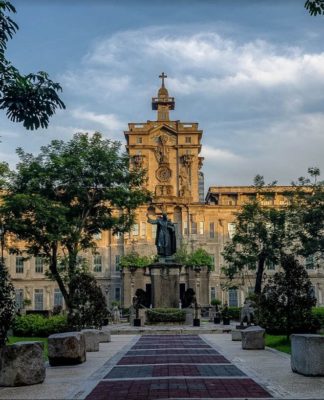THE CONTOURS of the beautiful Signal hills in Marawi city mesmerized Francisco “Dopy” Doplon as a kid. At first, his doodles were no better than others his age. Nobody appreciated his sketches until he was 10 when his family and friends praised him for his rendition of the Sacred Heart of Jesus.
From then on, he has never stopped drawing and growing in the arts. He even entered the University of Santo Tomas for training.
“Even as a kid, I have always dreamed of exploring a bigger world—much bigger than everything I see in our city,” Doplon said. “And I know UST will help me with that dream. That’s why I enrolled here to become a better artist.”
Now, the Thomasian family applauds this College of Fine Arts and Design (CFAD) alumnus for his artistic feats, which include designing the official logo of the University’s 400th anniversary.
Doplon has etched his name in both local and international competitions. His book, Ina and the Bikol People, won Best in Print award in the 2006 Hewlette Packard Indigo contest in Bangkok, Thailand. His nature-inspired cover design outshone other entries from Singapore, Thailand, Indonesia, and Malaysia.
Doplon also won two Manila Critics Circle National Book awards for designing the book covers of Homage by Jaime Zobel in 1996, and Silence by Arturo Luz in 2002. He also received an Anvil Award of Excellence for the Nestle Corporate brochure last 2000.
“The secret behind success is never to give up. Just hold on to your dreams and everything good will follow,” Doplon told the Varsitarian. “Focus and everything will end well.”
For 20 years now, Doplon and co-owner Dani de Mesa have been running the Artone Design and Communications in Makati, which works for blue-chips clients such as the Ayala Corporation, Asian Institute of Management, Cultural Center of the Philippines, Citibank, Coca-Cola Bottlers, and Nestlé Philippines, Inc.
Picking up the brush
Born in Marawi, Doplon was immersed and inspired by the traditionally elaborate and ornate Maranao art.
The printed bandanas, multi-colored vintas, Muslim posters and mosques that Doplon saw almost everyday on his way to school influenced the style he employs in his works.
“It helped a lot that I grew in Mindanao. Our culture in Marawi is so rich that I grew to love the arts,” he said.
But the University further honed Doplon’s skill as an artist. In fact, it was in his college days in UST that his moniker “Dopy” was coined.
“One of my professors was just so fond of rhyming names. And I was a victim,” he recalled. “One day, he started calling me ‘Dopy’ to rhyme my last name, Doplon. Now, everybody calls me Dopy—even my daughters,” he said.
In 1965, Doplon was recruited by a professor to join his studio as a graphic designer and commercial artist.
“My professor noticed my unique talent. He would pick me to draw sample outputs on blackboards to help him discuss our lectures,” he said.
After graduating from CFAD, Doplon pursued graphic designing and he worked for Girl Friday Design, an advertising agency and one of the first graphic design shops in the country. He also served as creative director of the country’s first international magazine, Sunburst, and of the in-flight magazine of Philippine Airlines, Mabuhay.
Doplon makes it a point to update himself on the latest trends in designing. He said that in this competitive industry, one can only survive if one becomes mindful of what is “in” and what is “not.”
“Awareness of the present age features good quality in designs. And of course, it definitely attracts more customers,” he said. But everything must start from scratch. If you don’t know the basics, then nothing else could follow,” he said.
Coming of age
Doplon’s talent was again complimented when his entry for the 2011 logo-making contest of UST was selected as UST’s official quadricentennial logo.
“I was not expecting to pull off the contest,” Doplon said. “But definitely, that was a big honor for me, especially when I hear my name mentioned by other Thomasians.”
Doplon said that he was, at first, hesitant to make an entry for the UST 2011 logo.
“Honestly, I wasn’t sure if I should submit a logo entry because my design came later than the other entries,” he said. “But my colleagues in college contacted me and pushed me to make one. I didn’t want to disappoint them.”
Called “Tongues of fire,” Doplon’s logo design contains the UST Main Building tower. Above it are four tongues of fire that illustrate the word “UST”, which also stand for the 400 years existence of the University.
“I tried to make it simple but captivating at the same time,” Doplon said. “As you see, I chose the colors orange and yellow as they look cool and capture the tastes of the present.”
Today, Doplon earns more than just applause and praise for his body of works such as Layers, Levels and Light, with industrialist and photographer Jaime Zobel de Ayala and graphic artist John Marin Flores; and award-winning coffeetable books Glory and Gold, Homage, The Island.
Doplon runs his own exhibit of art books at the Ayala Museum.
“More than earning riches and cash, what’s more important is that people appreciate my art. That alone gives me completion and satisfaction,” he said.
Despite his blossoming career, Doplon keeps to his humble ways.
“Although it feels so good to earn praises, I never let that go into my head,” he said. “I keep in mind that these blessings were given by God. And I can’t offer anything more but continue doing well in my work.”
As he continues to create fresh ideas in his graphic designs and digital artworks, Doplon wishes only one more thing—to help future designers succeed.
“If there’s one thing I should do, that is to pass on my knowledge to the next age group. And I must tell them, never give up,” he said. Rieze Rose T. Calbay















